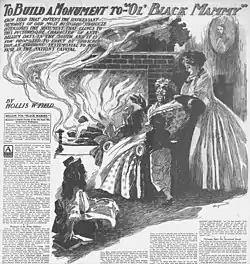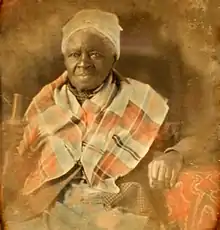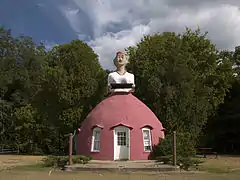Mammy stereotype
A mammy, also spelled mammie,[2] is a U.S. stereotype, especially in the South, for a black woman who worked in a white family and nursed the family's children.[3] The mammy figure is rooted in the history of slavery in the United States. Black slave women were tasked with domestic and childcare work in white American slaveholding households.



History
One of the earliest fictionalized versions of the mammy figure is Aunt Chloe in Harriet Beecher Stowe's Uncle Tom's Cabin, which was first published in 1852.[4] As the mammy figure progressed into the 20th century, the persona changed over time into perhaps a mythology. Memoirs that describe the roles of mammies from the 1890s to the 1920s downplayed the mammy's relationship with her family.[4]
Some scholars see the mammy figure as rooted in the history of slavery in the United States. Slave African American women were tasked with the duties of domestic workers in white American households. Their duties included preparing meals, cleaning homes, and nursing and rearing their owners' children. Out of these circumstances arose the image of the mammy.[5]
While originating in the slavery period, the mammy figure rose to prominence during the Reconstruction Era. Some scholars feel that in the Southern United States, the mammy played a role in historical revisionism efforts to reinterpret and legitimize their legacy of chattel slavery and racial oppression. The mammy image has endured into the 20th and 21st centuries. In 1923, the United Daughters of the Confederacy proposed the erection of a mammy statue on the National Mall. The proposed statue would be dedicated to "The Black Mammy of the South".[5]
The historicity of the mammy figure is questionable. Historical accounts point to the identity of most female domestic servants as teenagers and young adults, not "grandmotherly types" such as the mammy. Melissa Harris-Perry has argued that the mammy was a creation of the imagination of the white supremacy, which reimagined the powerless, coerced slave girls as soothing, comfortable, and consenting women.[5] In 1981, Andy Warhol included the mammy in his Myths series, alongside other mythological and folklore characters such as Santa Claus, Mickey Mouse, and Superman.[5]
In Mammy: A Century of Race, Gender, and Southern Memory (2008), Kimberly Wallace-Sanders argued that the mammy's stereotypical attributes point to the source of her inspiration: "a long lasting and troubled marriage of racial and gender essentialism, mythology, and southern nostalgia."[5]
The romanticized mammy image survives in the popular imagination of the modern United States. Psychologist Chanequa Walker-Barnes argues that political correctness has led to the mammy figure being less prevalent in the 21st-century culture, but the mammy archetype still influences the portrayal of African-American women in fiction, as good caretakers, nurturing, selfless, strong, and supportive, the supporting characters to white protagonists. She cites as examples Miranda Bailey, Mercedes Jones, and Ivy Wentz.[5]
Fictional characteristics
The mammy is usually portrayed as an older woman, overweight, and dark skinned. She is an idealized figure of a caregiver: amiable, loyal, maternal, non-threatening, obedient, and submissive. The mammy figure demonstrates deference to white authority. On occasion, the mammy is also depicted as a sassy woman. She is devoted to her owners/employers and her primary goal in life is to care for their needs. In some portrayals, the mammy has a family of her own. But her caregiving duties always come first, leading to the mammy being portrayed as a neglectful parent or grandparent.[5] And while the mammy is devoted to her white family, she often treats her own family poorly. Moreover, she has no black friends.[6]
Melissa Harris-Perry describes the relationship between the mammy and other African Americans in Sister Citizen: Shame, Stereotypes, and Black Women in America (2011) by summarizing that "Mammy was not a protector or defender of black children or communities. She represented a maternal ideal, but not in caring for her own children. Her love, doting, advice, correction, and supervision were reserved exclusively for white women and children."[5]
This stereotype contrasts with the Jezebel stereotype, which depicts younger African-American women as conniving and promiscuous. The mammy is occasionally depicted as a religious woman. More often than not, the mammy is an asexual figure, "devoid of any personal desires that might tempt her to sin". This helps the mammy serve as both a confidant and a moral guide to her young charges, capable of keeping them in line.[5]
Kimberly Wallace-Sanders includes other characteristics of the mammy in Mammy. A Century of Race, Gender, and Southern Memory (2008): A large dark body, a round smiling face, a deeply sonorous and effortlessly soothing voice, a raucous laugh. Her personal attributes include infinite patience, self-deprecating wit, an implicit understanding and acceptance of her own inferiority, and her devotion to whites.[5] The mammy was also large-breasted, desexualized, and potentially hostile towards black men. Many of these characteristics were denied to African-American female slaves but were generally attributed to the mammy.[7]
Clothing
The dress often reflects the status of her owner. The mammy is usually neat and clean and wears attire that is suitable for her domestic duties. Sometimes a mammy considers herself to be dressed up, but that is usually just an addition of a bonnet and a silk velvet mantle, which probably belonged to her owner.[8]
Education
Like most slaves at that time, the mythical mammy is often illiterate, though intelligent in her own sense. However, as intelligent as she may have been, most of her intelligence is a result of past experiences and conflicts. In particular, a mammy of an aristocratic family can be identified by her air of refinement.[8]
Living conditions
When the mammy does not stay in the house of her owner or is not busy attending to the needs of the owner's children, she usually lives with her husband and children in a cabin that is distinguished from the cabins of the other enslaved people in either size or structure. Her cabin stands near the owner's house, but at a distance from the cabins of the other enslaved people.[8]
Although her duties are far less tiring and strenuous than those of the other slaves, her hours are often long, leaving little time for her own leisure. It is not until the mammy becomes too old for these duties that she enjoys any home life of her own, since she is always preoccupied with the home life of her owner. There is a flexibility about the mammy's duties that distinguishes her from just being an ordinary nurse or a wet nurse, even though there is a possibility that she can perform either of these tasks. In some of the more wealthy households, the fictional mammy has assistants that would help her take care of the household's children. These women are often much younger than the mammy herself.[8]
The mammy, unlike other slaves, is usually not up for sale, and the children of the mammy are kept in the same family for as long as possible, retaining the same relationships that the mammy has with the owner.[8]
Roles in plantation households
The fictional role of the mammy in plantation households grows out of the roles of enslaved African-Americans on the plantation. African-American slaves played vital roles in the plantation household. For the mammy, the majority of these duties generally are related to caring for the children of the owner's family, thus relieving the mistress of the house of all the drudgery work that is associated with child care. When the children have grown up and were able to take care of themselves properly, the mammy's main role is to help the mistress with household tasks. As her years of service with the family increase, the mammy's sphere of influence increases as well. She is next to the mistress in authority and has the ability to give orders to everybody in the house.[8]
The mammy is often considered to be part of the slaveholding family as much as its blood members were considered. Although she is considered of a lower status, she is still included in the inner circle. She has often been referred to as a "unique type of foster motherhood". Aside from just tending to the needs of the children, the mammy is also responsible for teaching the proper etiquette to them, such as addressing the elders on the plantation as "aunt" or "uncle", as well as what was best to say on a particular occasion and what was not. The mammy is able to discipline her charges whenever they do something undesirable, and is able to retain their respect towards her, even after the children have grown to adults.[8]
Media portrayal

Like the image of Aunt Jemima, the image of the mammy was given a contemporary makeover as well as she appeared in television sitcoms. Some of the more contemporary features that the mammy received were that her head rag was removed and she became smaller, as well as lighter in complexion. In addition, her owner was not always white.[9]
Some contemporary television sitcoms which featured mammies include Maude, where the character Florida, played by Esther Rolle, worked as a domestic for a white family. A spin-off titled Good Times was made, where Rolle's character became the center of the series; the show focused on her family, which lived generally happy lives in a low-income housing project. Other television series that featured mammies as characters include That's My Mama, Gimme a Break! and What's Happening!!.[10]
When other contemporary mammies emerged, they usually retained their occupation as a domestic and exhibited these physical feature changes; however, their emotional qualities remained intact. These contemporary mammies continued to be quick-witted and remained highly opinionated. A new twist in the outlook of the contemporary mammy occurred in the sitcom The Jeffersons, where Florence, a maid played by Marla Gibbs, worked for an affluent African-American family.[4]
One of the more recent caricatures that still exist in today's society is Tyler Perry's Madea character. Madea is a massive heavyset black woman who is known for her violent acts throughout the Perry films. She contributes the stereotypes about African-American women being bitter, mean, and violent towards everyday people. Perry also has another character that contributes to the stereotypes among the African-American community which is the "Crack Mother" caricature. He received a lot of backlash for regenerating this stereotype of black mothers. In the sitcom House of Payne there is a crack mother character who cannot provide for her children and she undergoes the stereotypical detoxification.[11]
Additionally, mammy characters were a staple of minstrel show, giving rise to many sentimental show tunes dedicated to or mentioning mammies, including Al Jolson's My Mammy from The Jazz Singer and Judy Garland's performance of Swanee from A Star is Born (a song originally made popular by Jolson). Various mammy characters appeared in radio and TV shows. One prominent example was the radio and later short-lived television series Beulah, which featured a black maid named Beulah who helped solve a white family's problems. In the 1940s and early 1950s, Mammy Two Shoes, the housekeeper in 19 Tom and Jerry shorts, presented an animated example of the mammy, complete with dark skin and African American vernacular English. As a parody of this stereotype, the 1984 Frank Zappa album Thing-Fish featured characters called "mammy nuns".
In the early 20th century, the mammy character was common in many films. Hattie McDaniel won an Academy Award for Best Supporting Actress for her performance as "Mammy" in Gone with the Wind in 1939.[12] Common roles in American mass media seeming to be reserved for the mammy stereotype include secretaries, medical assistants and greasy spoon diner waitresses.
Fictional mammy characters
The mammy character is used in films, novels, and television shows, including:
Advertising
- Aunt Jemima, portrayed by freed slave Nancy Green, 1893–1923. Following Nancy Green are a long line of Aunt Jemimas, including: Anna Robinson (1923–1951), Edith Wilson (1948–1966), Ethel Ernestine Harper (the 1950s)
Animation
- Mammy Two Shoes, Tom and Jerry series
- "Scrub Me Mama with a Boogie Beat": the 1941 hit boogie-woogie song's animated short features many depictions of mammy figures, starting with the title card, through to the admonishment, "Look here, Mammy. That ain't no way to wash clothes! What you all need is rhythm!" to "The End" displayed across a mammy's backside.
Comics
- Rachel, Bobby's Make-Believe, 1919, Gasoline Alley, 1921. [13]
Doll
The character Beloved Belindy was designed by Raggedy Ann creator Johnny Gruelle. This character was sold as a doll and featured in books.[14]
Films
- Mammy as played by Jennie Lee in D. W. Griffith's 1915 silent epic The Birth of a Nation.
- Aunt Dilsey, played by Hattie McDaniel, Judge Priest, 1934.
- Mammy, played by Hattie McDaniel, Gone with the Wind, 1939.
- Louise Beavers played a mammy, cook, slave, or servant in almost all of her film roles. The more well known are: Imitation of Life (1934), Belle Starr (1941), Holiday Inn (1942), Jack London (1943) and I Dream of Jeanie (1952).
- Delilah, played by Virginia Capers, Big Jake, 1971
- Louise, played by Margo Moorer, Forrest Gump, 1994
- Ma Soupswill, Rare, Grabbed by the Ghoulies, 2003
- Aunt Tempe, played by Hattie McDaniel, in Song of the South, 1946
Novels
- Aunt Chloe, Uncle Tom's Cabin, 1852
- Henrietta Beech, Petals on the Wind, 1980
- Beloved Belindy Johnny Gruelle[15]
Television
- Beulah Brown, originally a character on the radio sitcom Fibber McGee and Molly played by white actor Marlin Hurt, later played on television by Ethel Waters, then Louise Beavers, The Beulah Show, 1950–1953
- Belle, played by Madge Sinclair, Roots, 1977
- Mamie, played by Diva Tyler, Eastbound and Down, 2009-2013
Notes
- "Portrait of Mauma Mollie". World Digital Library. 1850. Retrieved June 2, 2013.
- Denise DeCaires Narain, Contemporary Caribbean Women's Poetry: Making Style, p. 87: "[...] the continued commodification of the black woman as 'mammie' figure."
- "Definition of MAMMY". www.Merriam-Webster.com. Retrieved January 21, 2019.
- "The Mythification of the Mammy". xroads.Virginia.edu. Archived from the original on October 13, 2018. Retrieved January 21, 2019.
- Walker-Barnes (2014), p. 85-88
- "The Mammy Caricature". Ferris Statue University.
- Wallace-Sanders, Kimberly (2008). Mammy: A Century of Race, Gender, and Southern Memory. Ann Arbor: University of Michigan Press. pp. 3, 6. ISBN 978-0472034017.
- Parkhurst, Jessie W. (1938). "The Journal of Negro History". The Journal of Negro History. 23 (3): 349–369. doi:10.2307/2714687. JSTOR 2714687.
- Jewell, K. Sue; Staff, Jewell K. S. (January 21, 1993). From Mammy to Miss America and Beyond: Cultural Images and the Shaping of US Social Policy. Psychology Press. ISBN 9780415087773. Retrieved January 21, 2019 – via Google Books.
- Page, Yolanda Williams (2011-10-31). Icons of African American Literature: The Black Literary World. ABC-CLIO. ISBN 978-0-313-35203-4.
- Carpenter, Tracy (December 1, 2012). "Construction of the Crack Mother Icon". Western Journal of Black Studies.
- Haskell, Molly (2010). Frankly, My Dear: Gone With the Wind Revisited. Icons of America. Yale University Press. pp. 213–214. ISBN 978-0-300-16437-4.
- "Frank O. King". lambiek.net. Retrieved January 21, 2019.
- https://www.washingtonpost.com/archive/lifestyle/style/1986/08/24/its-raggedytime/e6b16ead-82c7-4406-a7dd-bf8e65a1782c/
- https://www.washingtonpost.com/archive/lifestyle/style/1986/08/24/its-raggedytime/e6b16ead-82c7-4406-a7dd-bf8e65a1782c/
Sources
- Walker-Barnes, Chanequa (2014), "Jezebels, Mammies, and Matriarchs", Too Heavy a Yoke: Black Women and the Burden of Strength, Wipf and Stock, ISBN 978-1620320662
References
- Bernstein, Robin, Racial Innocence: Performing American Childhood from Slavery to Civil Rights (New York: New York University Press, 2011), 157, 174–176, 180–181.
- Bogle, Donald, Toms, Coons, Mulattoes, Mammies, & Bucks: An Interpretive History of Blacks in American Films (New York: Continuum, 1973/1994), 57.
- Camacho, Roseanne V., "Race, Region, and Gender in a Reassessment of Lillian Smith." Southern Women: Histories and Identities. Columbia: University of Missouri Press, 1992. p. 168.
- Clinton, Catherine, The Plantation Mistress: Woman's World in the Old South (New York: Pantheon Books, 1982), 201–202.
- Jewel, K. Sue, From Mammy to Miss America and Beyond: Cultural Images and the Shaping of US Social Policy, 1993.
- Parkhurst, Jessie W., "The Role of the Black Mammy in the Plantation Household", The Journal of Negro History, Vol. 23, No. 3, July 1938
- Smith, Lillian, Killers of the Dream. New York: W.W. Norton, 1949. p. 123-4.
- Thurber, Cheryl, "The Development of the Mammy Image and Mythology." Southern Women: Histories and Identities, Columbia: University of Missouri Press, 1992. p. 96.
- Turner, Patricia A., Ceramic Uncles & Celluloid Mammies: Black Images and Their Influence on Culture (New York: Anchor Books, 1994), 44.
External links
| Wikimedia Commons has media related to Mammies. |
- Pilgrim, David. "The Mammy Caricature". Jim Crow Museum of Racist Memorabilia. Ferris State University, Michigan.
- Mammy Dearest: African-American House Servants in Birth of the Nation, Gone with the Wind, and Song of the South American Studies at the University of Virginia
- Wallace-Sanders, Kimberly (June 15, 2009). "Southern Memory, Southern Monuments, and the Subversive Black Mammy". Southern Spaces. 2009. doi:10.18737/M7PK6W.